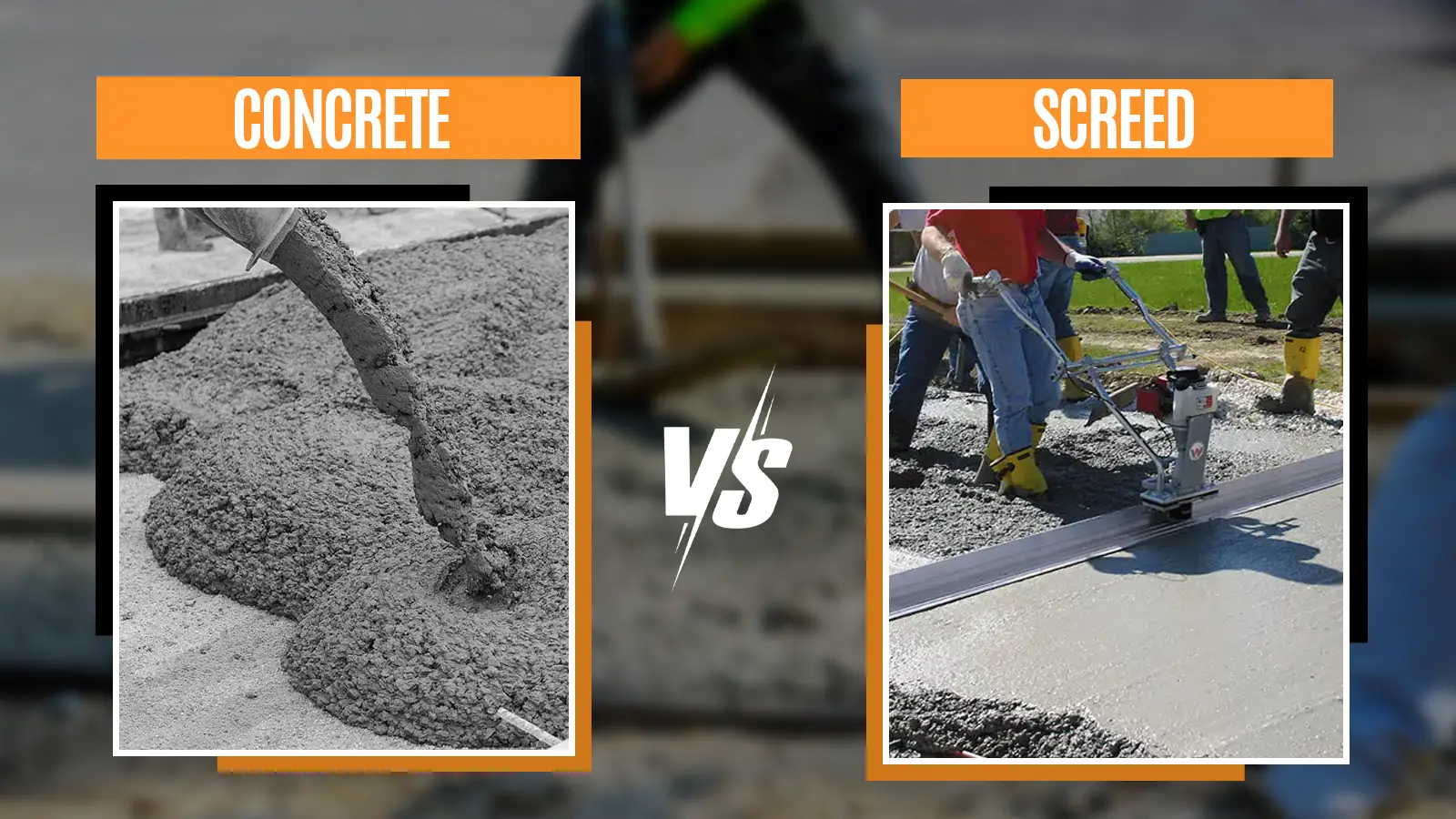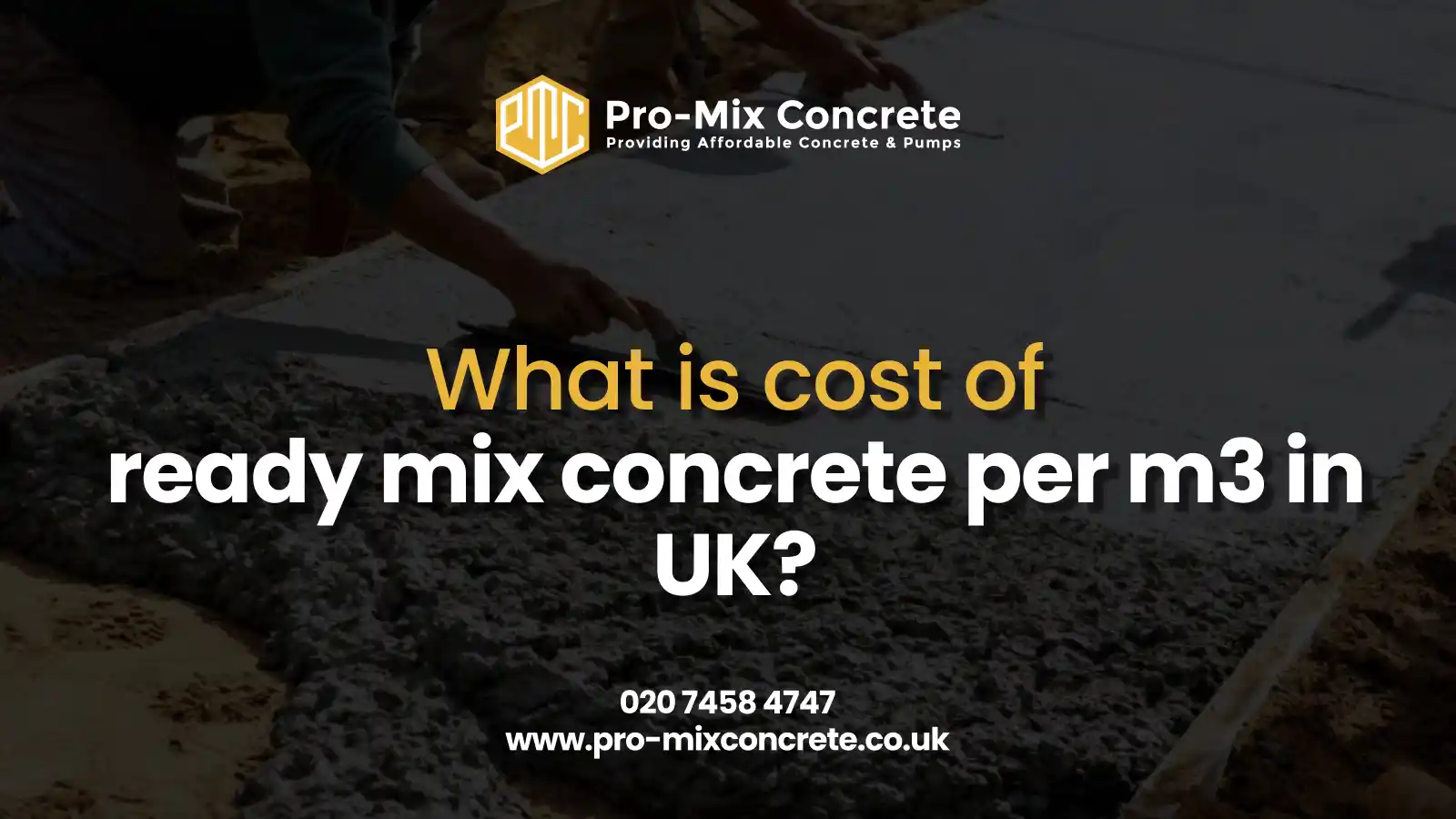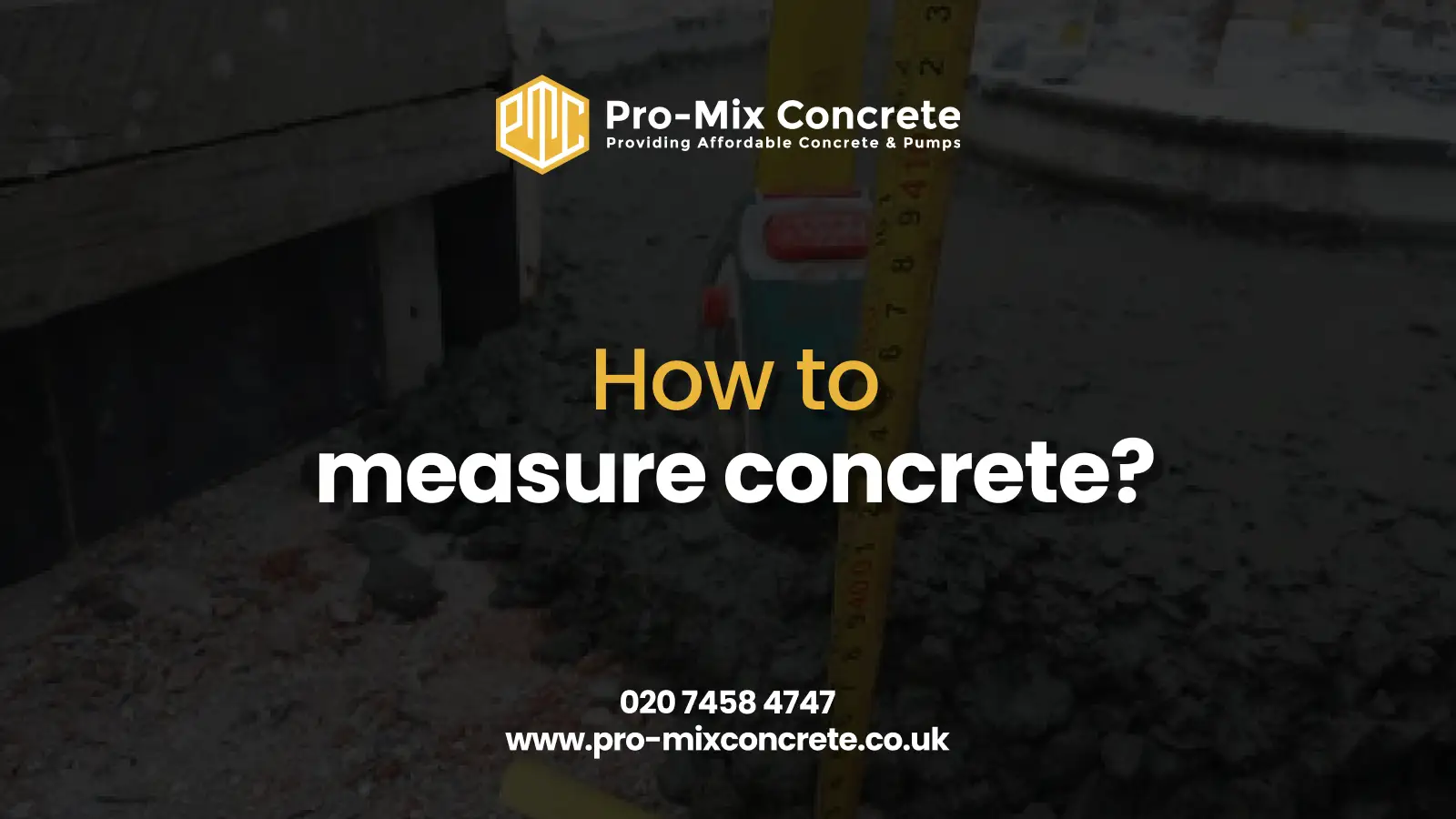[TL;DR]
Choosing between concrete and screed depends on your project’s specific requirements and intended use.
- Concrete is a structural material made with coarse aggregates, ideal for foundations, driveways, and load-bearing applications requiring high strength and durability. It requires a minimum of 100mm thickness and takes 24-48 hours to set.
- Screed uses fine aggregates to create smooth, level surfaces perfect for indoor flooring applications and preparing surfaces for floor coverings. It can be applied in 25-50mm layers and sets in just 4-5 hours.
Concrete and screed are essential construction materials that serve different purposes in building projects. Concrete provides structural strength for foundations and load-bearing applications, while screed creates smooth, level surfaces for flooring installations.
Choosing the wrong material can lead to costly mistakes, project delays, and performance issues. The right choice depends on your project’s structural requirements, thickness limitations, and intended use. Understanding the key differences between these materials helps you make informed decisions that save time, money, and ensure long-lasting results.
If you need expert guidance on your concrete needs, get in touch with our team at Pro Mix Concrete and ensure your project uses the optimal material from day one.
Connect with Experts: 020 7458 4747
What Is Concrete?
Concrete is a composite construction material made from cement, water, and coarse aggregates that hardens into a strong, durable substance suitable for structural applications. This fundamental building material forms the backbone of modern construction projects.
Composition and Characteristics
Concrete consists of Portland cement, water, and coarse aggregates like gravel or crushed stone ranging from 5mm to 20mm in diameter. The coarse aggregates give concrete its characteristic rough texture and exceptional compressive strength.
The material typically achieves compressive strengths of 20-40 MPa (megapascals) or higher, making it ideal for structural applications. Its rough surface texture provides excellent bonding with reinforcement materials and subsequent layers.
Key characteristics of concrete include:
- High compressive strength suitable for load-bearing applications
- Rough, coarse texture from large aggregate particles
- Excellent durability in outdoor environments
- Strong resistance to weather and chemical exposure
- Natural fire resistance properties
Common Uses of Concrete
Concrete serves as the primary structural material for foundations, building slabs, driveways, sidewalks, and outdoor construction projects. Its strength and durability make it essential for load-bearing applications.
Typical concrete applications require a minimum thickness of 100mm to provide adequate structural integrity. Thicker sections are necessary for heavy-duty applications like industrial floors or structural beams.
Primary concrete applications:
- Building foundations and footings
- Structural slabs and beams
- Driveways and parking areas
- Sidewalks and outdoor walkways
- Retaining walls and structural elements
The growing demand for concrete reflects its essential role in construction. The global concrete materials market is projected to grow from £230.97 billion in 2024 to £237.94 billion in 2025, with a compound annual growth rate (CAGR) of 3.0%.
Setting and Curing Time
Concrete requires 24-48 hours for initial setting, during which it gains enough strength for light foot traffic. Full-strength development takes 28 days under proper curing conditions.
Proper moisture control during curing is critical for achieving optimal strength. Concrete must be kept moist during the first week to prevent cracking and ensure maximum durability.
Temperature affects setting time significantly. Cold weather slows the process, while hot conditions accelerate setting but may compromise final strength without proper curing techniques.
What Is Screed?
Screed is a smooth, level surface material made from cement, water, and fine aggregates designed to create finished floors and prepare surfaces for final floor coverings. It focuses specifically on providing precise leveling and smooth finishes essential for professional flooring installations.
Composition and Characteristics
Screed uses cement, water, and fine aggregates like sharp sand with a maximum grain size of 4mm. The fine particles create a smooth, dense surface perfect for flooring applications.
The fine aggregate composition allows screed to be troweled to a smooth, level finish that’s ideal for tile, carpet, or other floor covering installations. Its density provides excellent thermal conductivity for underfloor heating systems.
Key screed characteristics:
- Smooth, fine texture from small aggregate particles
- Excellent leveling properties for surface preparation
- Strong thermal conductivity for heating systems
- Dense, non-porous surface when properly finished
- Precise thickness control capabilities
Types of Screed
Different screed types serve specific applications. Traditional cement screed works for general applications, while specialised varieties handle unique requirements like fast-track construction or enhanced durability.
Common screed types include:
- Traditional cement screed for standard applications
- Bonded screed that adheres directly to concrete
- Floating screed with insulation underneath
- Anhydrous screed for faster drying times
- Polymer-modified screed for enhanced properties
Typical screed thickness ranges from 25-50mm for bonded applications, or up to 100mm for floating installations with insulation layers.
Common Uses of Screed
Screed is primarily applied as a top layer over concrete subfloors to create level, smooth surfaces for final floor installations. It’s essential for preparing surfaces that require precise leveling.
Main screed applications:
- Floor leveling over concrete slabs
- Underfloor heating system encapsulation
- Base preparation for tile and stone installations
- Creating falls to drains in wet areas
- Smoothing irregular concrete surfaces
The floor screed market demonstrates impressive growth, valued at £10.06 billion in 2023 and projected to expand at 6.2% annually through 2032. This growth reflects increasing demand for precision flooring solutions driven by urbanization and infrastructure development in emerging economies worldwide.
Setting and Drying Time
Screed sets much faster than concrete, typically becoming walkable within 4-5 hours of application. This rapid setting allows faster project progression and reduced downtime.
However, screed is more sensitive to moisture conditions during setting. Proper humidity control prevents surface crazing and ensures optimal strength development.
Complete drying for floor covering installation takes longer, typically 1-2 weeks, depending on thickness and environmental conditions. Moisture testing ensures readiness for final flooring materials.
4 Key Differences Between Concrete and Screed
Understanding the fundamental differences between these materials helps determine which suits your specific project requirements. The screed vs concrete decision affects everything from strength to application methods.
-
Composition and Texture
Concrete uses coarse aggregates (5-20mm) that create a rough, textured surface suitable for structural applications. On the other hand, screed uses fine sand particles (up to 4mm) that produce smooth, level finishes.
The aggregate size difference directly impacts surface texture and intended use. Concrete’s rough surface bonds well with reinforcement and subsequent layers, while screed’s smooth finish prepares surfaces for floor coverings.
This composition difference makes concrete ideal for structural work and screed perfect for finishing applications.
-
Strength and Durability
Concrete delivers high compressive strength (20-40+ MPa) essential for structural integrity and load-bearing capacity. Its durability supports long-term structural performance under heavy loads.
Screed provides lower compressive strength, typically 15-25 MPa, sufficient for surface finishing but not structural applications. Its primary function focuses on creating level, smooth surfaces rather than bearing loads.
Both materials offer good durability when properly applied, but concrete excels in structural situations while screed performs best as a finishing material.
-
Thickness and Application
Concrete requires a minimum 100mm thickness for structural integrity, with many applications needing 150-200mm or more. Thicker sections provide greater strength and durability.
Screed applications range from 25-50mm for bonded installations to 65-100mm for floating systems. These thinner applications focus on surface preparation rather than structural support.
Thickness guidelines:
- Concrete: Minimum 100mm, typically 150-200mm+
- Bonded screed: 25-50mm over concrete
- Floating screed: 65-100mm with insulation
- Unbonded screed: 50-65mm minimum thickness
-
Setting Time and Project Timelines
Concrete’s 24-48 hour setting time requires longer project schedules but provides superior structural strength. Full-strength development takes 28 days for critical applications.
Screed’s 4-5 hour setting time enables faster project completion and quicker access for follow-up trades. This speed advantage reduces overall construction timelines significantly.
The time difference impacts project scheduling, labor coordination, and overall construction efficiency.
Looking for expert advice on material selection for your specific project? Get a free consultation with our specialists at Pro-Mix Concrete, who understand local conditions and application requirements.
Get Your Quote Now: 020 7458 4747
Concrete vs. Screed Comparison Table
|
Aspect |
Concrete |
Screed |
|
Aggregate Size |
5-20mm (coarse) |
Up to 4mm (fine sand) |
|
Surface Texture |
Rough, coarse |
Smooth, fine |
|
Compressive Strength |
20-40+ MPa |
15-25 MPa |
|
Typical Thickness |
100-200mm+ |
25-100mm |
|
Setting Time |
24-48 hours |
4-5 hours |
|
Primary Use |
Structural applications |
Surface finishing |
|
Weather Resistance |
Excellent |
Limited (indoor use) |
|
Cost per m² |
Higher material cost |
Lower material cost |
|
Installation Complexity |
Moderate to high |
Moderate |
|
Curing Time |
28 days full strength |
1-2 weeks for covering |
When to Use Screed vs Concrete?
Selecting the right material depends on your project’s structural requirements, load expectations, and intended final use.
Structural vs. Finishing Needs
Use concrete for any application requiring structural strength, load-bearing capacity, or outdoor durability. Its high compressive strength handles heavy loads, vehicle traffic, and weather exposure.
Choose screed for indoor surface preparation, floor leveling, and creating smooth bases for floor coverings. Its fine texture and precise leveling capabilities excel in finishing applications.
Concrete applications:
- Building foundations and structural elements
- Driveways and vehicle access areas
- Outdoor patios and walkways
- Industrial floors with heavy equipment
- Structural slabs and load-bearing surfaces
Screed applications:
- Indoor floor leveling and preparation
- Underfloor heating system installation
- Tile and stone base preparation
- Creating precise falls in wet areas
- Smoothing irregular concrete surfaces
Specific Project Examples
Concrete works best for foundations where structural integrity is paramount.
- A typical house foundation requires 150-200mm of concrete thickness to support building loads safely.
- Driveways need concrete’s durability to handle vehicle weights and weather exposure. Standard residential driveways use 100-150mm concrete with appropriate reinforcement.
Screed excels in preparing floors for tile installations.
- A 40mm bonded screed over concrete provides the smooth, level surface essential for professional tile work.
- Underfloor heating systems require screed encapsulation to ensure even heat distribution and protect heating elements from damage.
Environmental and Practical Considerations
Outdoor applications always require concrete due to weather exposure, freeze-thaw cycles, and UV radiation. Concrete’s durability handles these conditions effectively.
Indoor environments suit screed applications where weather isn’t a factor and smooth finishes are a priority. Climate-controlled conditions optimise screed performance.
Moisture sensitivity affects both materials differently. Concrete handles moisture exposure better, while screed requires controlled drying conditions for optimal results.
Environmental factors to consider:
- Weather exposure requires concrete durability
- Indoor applications favour the screed’s smooth finish
- Moisture conditions affect curing and performance
- Temperature variations impact setting times
- Load requirements determine strength needs
Steps to Choose the Right Material for Your Project
Making the correct screed vs concrete decision requires evaluating multiple project factors. These practical guidelines help ensure you select the optimal material for lasting results.
1. Start with Your Load Requirements
Your project’s weight expectations determine whether you need the concrete’s structural strength or the screed’s finishing capabilities. Heavy loads always require concrete’s superior load-bearing capacity.
Think about what your surface will support daily. A garage floor needs concrete to handle vehicle weights, while a bedroom floor preparing for carpet only needs a screed’s smooth screed finish.
Ask yourself these key questions:
- Will vehicles or heavy equipment use this surface?
- Are you planning static storage or dynamic loads?
- Could future needs require heavier equipment?
- What safety margins does your project require?
Consider tomorrow’s needs today. Installing concrete initially costs less than upgrading from screed later, when requirements change.
- Match Material to Your Finish Goals
Surface appearance and function guide material choice more than most people realise. Your intended final use determines which material delivers the best results.
Indoor floors destined for tile, carpet, or luxury vinyl need screed’s precision leveling. Outdoor patios and driveways perform better with concrete’s natural grip and weather resistance.
Think about who will see and use this surface. Client-facing areas benefit from smooth screed preparation, while utility areas often work fine with concrete’s functional finish.
Consider these finishing factors:
- Will the surface remain exposed or receive coverings?
- Do you need slip resistance for safety?
- How important is visual appearance?
- Are there specific texture requirements?
3. Balance Cost with Long-term Value
Smart material selection considers both upfront costs and long-term performance. Sometimes spending more initially saves money over the project’s lifetime.
Screed costs less per square meter but requires concrete underneath for structural support. Concrete costs more initially but handles both structural and surface needs in one application.
Cost comparison considerations:
- Material prices for your specific area requirements
- Labor complexity and time requirements
- Equipment rental or purchase needs
- Timeline impact on other trades and project completion
- Maintenance and replacement costs over time
Factor in regional pricing variations and seasonal availability when making cost comparisons.
4. Get Professional Input Early
Expert guidance prevents expensive mistakes and ensures optimal material selection for your specific conditions. Local professionals understand regional challenges that affect material performance.
Professional consultation ensures optimal material selection based on local conditions, building codes, and application-specific requirements. Expert advice prevents costly mistakes and ensures compliance with industry standards.
Moreover, advances in concrete technology, such as fibre-reinforced concrete, decorative finishes, and smart concrete solutions, are emerging trends expected to shape the market through 2029, offering enhanced durability and aesthetic possibilities for modern projects.
Bottom Line
Concrete excels in structural applications requiring high strength and outdoor durability, while screed provides smooth, level surfaces perfect for indoor flooring preparations. The key differences in composition, strength, thickness, and setting time directly impact project outcomes and costs. Professional consultation provides valuable insights based on local conditions and regulatory requirements.
Tired of guessing which material your project actually needs?
Stop second-guessing and start building with confidence. At Pro-Mix Concrete, we’ve seen too many projects go wrong because someone chose the wrong material. We’ve been mixing concrete and screed for decades, and we know exactly what works where.
Our team sticks around to make sure you get the results you’re paying for. Expert advice, perfect mixes, on-time delivery, and the kind of service that turns one-time customers into lifelong partners.
Call us today for a free consultation that could save you thousands and guarantee that your project achieves the strength, durability, and finish quality you deserve!
Get Your Quote Now: 020 7458 4747
Frequently Asked Questions
Concrete uses coarse aggregates for structural strength and durability, while screed uses fine sand to create smooth, level surfaces. Concrete provides structural integrity; screed offers precision finishing for flooring applications.
Use concrete for structural applications, foundations, driveways, outdoor areas, and load-bearing surfaces. Choose concrete when you need high compressive strength, weather resistance, or a minimum 100mm thickness requirement.
Screed is not recommended for outdoor use due to weather sensitivity and lower durability. Outdoor applications require concrete’s superior weather resistance, freeze-thaw durability, and structural strength capabilities.
Concrete requires a minimum 100mm thickness for structural integrity, typically 150-200mm for most applications. Screed thickness ranges from 25-50mm for bonded applications to 65-100mm for floating installations.
Concrete sets in 24-48 hours and reaches full strength in 28 days. Screed sets in 4-5 hours for foot traffic and is ready for floor coverings in 1-2 weeks, depending on thickness and conditions.
Traditional cement screed offers economical general use. Anhydrous screeds dry faster. Polymer-modified versions provide enhanced durability. Bonded screeds adhere to concrete; floating screeds include insulation layers underneath.
- Dennis Broderick
- Dennis Broderick is the founder and owner of Pro-Mix Concrete Company, a trusted name in ready-mix concrete solutions across the UK. With over 20 years of hands-on experience in the construction and concrete industry, Dennis brings unmatched expertise, practical insights, and a commitment to quality on every project - from residential driveways to large-scale commercial developments.
 BlogNovember 26, 2025Ready Mix Concrete Costs UK: 7 Key Factors That Affect Your Price Per m³
BlogNovember 26, 2025Ready Mix Concrete Costs UK: 7 Key Factors That Affect Your Price Per m³ BlogNovember 26, 2025How Long Does Concrete Take To Cure?
BlogNovember 26, 2025How Long Does Concrete Take To Cure? BlogNovember 20, 2025How To Measure Concrete With A Concrete Calculator?
BlogNovember 20, 2025How To Measure Concrete With A Concrete Calculator? BlogNovember 15, 2025What is the Mix Proportion of Concrete?
BlogNovember 15, 2025What is the Mix Proportion of Concrete?





